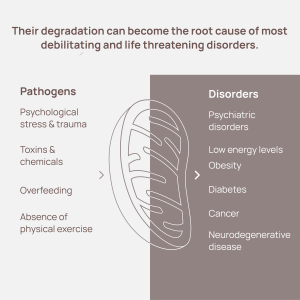What is Mitochondria Biogenesis?
What is Mitochondrial Biogenesis?
Mitochondrial biogenesis is the process by which cells increase their number of mitochondria, the organelles responsible for producing energy in the form of adenosine triphosphate (ATP).
Mitochondria are crucial for various cellular functions, including energy metabolism, regulation of metabolic pathways, and the maintenance of cellular homeostasis.
The process of mitochondrial biogenesis involves the growth and division of pre-existing mitochondria, as well as the synthesis of mitochondrial DNA (mtDNA), proteins, and lipids.
How to Improve Mitochondrial Biogenesis
- Regular Physical Activity:
- Aerobic Exercise: Activities like running, cycling, and swimming increase mitochondrial density in muscle cells. This type of exercise induces metabolic stress and increases the demand for ATP, stimulating the production of new mitochondria.
- Resistance Training: Strength training can also enhance mitochondrial biogenesis, especially when combined with aerobic exercise. It helps maintain muscle mass and function, which are important for metabolic health.
- Nutritional Interventions:
- Adequate Protein Intake: Sufficient dietary protein provides the necessary amino acids for mitochondrial protein synthesis.
- Nutrient Timing: Consuming carbohydrates and protein post-exercise can support recovery and mitochondrial biogenesis by replenishing glycogen stores and providing the necessary substrates for protein synthesis.
- Polyphenols and Antioxidants: Compounds found in foods like berries, green tea, and dark chocolate can support mitochondrial health by reducing oxidative stress.
- Caloric Restriction and Intermittent Fasting:
- These dietary strategies can activate pathways that promote mitochondrial biogenesis, such as the activation of AMPK and SIRT1, which help enhance mitochondrial function and longevity.
- Cold Exposure:
- Cold exposure, through methods like cold showers or cryotherapy, can stimulate the production of brown adipose tissue, which is rich in mitochondria. This process can enhance mitochondrial biogenesis and improve metabolic health.
- Pharmacological Agents and Supplements:
- Certain compounds, like resveratrol and metformin, have been shown to activate pathways involved in mitochondrial biogenesis, such as SIRT1 and AMPK. However, the use of these substances should be considered with caution and ideally under medical supervision.
- Adequate Sleep and Stress Management:
- Proper rest and recovery are essential for mitochondrial health. Chronic stress can impair mitochondrial function, so managing stress through mindfulness, meditation, or other techniques is beneficial.
Why is Mitochondrial Biogenesis Important as We Age?
- Maintaining Energy Levels:

- Mitochondria are responsible for producing the majority of the ATP required by cells.
- As we age, mitochondrial function often declines, leading to reduced energy levels.
- Enhancing mitochondrial biogenesis can help maintain energy production, supporting overall vitality.
- Metabolic Health:
- Mitochondria play a key role in metabolic processes, including the regulation of glucose and lipid metabolism.
- Improved mitochondrial function can help maintain metabolic health, reducing the risk of conditions like insulin resistance and type 2 diabetes.
- Muscle Health:
- Mitochondrial biogenesis supports muscle function and endurance.
- With age, muscle mass and function can decline, a condition known as sarcopenia.
- Promoting mitochondrial health can help preserve muscle mass and function, supporting mobility and physical performance.
- Cognitive Function:
- Mitochondria are also crucial for brain health.
- They provide the energy needed for neurotransmission and other brain functions.
- Enhanced mitochondrial function may support cognitive health and protect against neurodegenerative diseases.
- Reducing Oxidative Stress:
- Mitochondria are a primary source of reactive oxygen species (ROS), which can cause cellular damage.
- Improved mitochondrial function and biogenesis can help reduce ROS production and enhance the cell’s ability to detoxify these harmful molecules, thereby protecting cells from oxidative stress.
As we age, maintaining mitochondrial health becomes increasingly important for preserving overall health, vitality, and quality of life. Engaging in activities and practices that promote mitochondrial biogenesis can help counteract the natural decline in mitochondrial function associated with aging.
Rabbit hole…Mitochondria and Oxidative Stress connection?
Mitochondria are crucial for cellular energy production but are also a primary source of reactive oxygen species (ROS), which can cause oxidative stress if not properly managed.
The mechanisms by which improved mitochondrial function and biogenesis can reduce ROS production and enhance the cell’s ability to detoxify harmful molecules involve several key processes:
1. Efficient Electron Transport Chain (ETC) Function:
- Mechanism: Mitochondria generate ATP through the electron transport chain (ETC), a series of protein complexes located in the inner mitochondrial membrane. Electrons are passed along these complexes, ultimately reducing oxygen to water. During this process, if electrons leak prematurely from the ETC, they can interact with oxygen to form superoxide, a type of ROS.
- Improvement: Enhanced mitochondrial function often means a more efficient ETC with fewer electron leaks. When the ETC functions efficiently, the likelihood of electrons escaping and forming ROS decreases, reducing oxidative stress.
2. Increased Antioxidant Defense:
- Mechanism: Mitochondria and cells have intrinsic antioxidant systems that neutralize ROS. Key antioxidants include superoxide dismutase (SOD), which converts superoxide into hydrogen peroxide, and catalase and glutathione peroxidase, which further break down hydrogen peroxide into water.
- Improvement: Enhanced mitochondrial function and biogenesis can upregulate the expression of these antioxidant enzymes. This increase in antioxidant capacity helps neutralize ROS more effectively, minimizing potential damage.
3. Enhanced Mitochondrial Biogenesis:
- Mechanism: Mitochondrial biogenesis increases the number of mitochondria in cells, which can help dilute the production of ROS per mitochondrion. More mitochondria mean that the workload for ATP production can be spread out, reducing the strain on individual mitochondria and the associated risk of ROS production.
- Improvement: With more mitochondria, the demand for energy production can be met with less stress on each mitochondrion, resulting in less electron leakage and ROS formation.
4. Mitophagy and Mitochondrial Quality Control:
- Mechanism: Cells have mechanisms for removing damaged or dysfunctional mitochondria through a process called mitophagy. This is crucial because damaged mitochondria can produce higher levels of ROS.
- Improvement: Improved mitochondrial function is often associated with enhanced mitophagy, leading to the removal of defective mitochondria and the maintenance of a healthy mitochondrial population. This quality control reduces the overall production of ROS and oxidative stress.
5. Adaptive Cellular Responses:
- Mechanism: Cells can activate stress response pathways that increase their ability to cope with oxidative stress. For example, the activation of the Nrf2 pathway can upregulate the expression of genes involved in antioxidant defense and detoxification.
- Improvement: Enhanced mitochondrial function and biogenesis can activate these adaptive responses, further bolstering the cell’s capacity to neutralize ROS and repair oxidative damage.
6. Reduced Inflammatory Signaling:
- Mechanism: ROS can act as signaling molecules that trigger inflammatory responses. Chronic inflammation can exacerbate oxidative stress, creating a vicious cycle of cellular damage.
- Improvement: By reducing ROS levels through improved mitochondrial function, the initiation of inflammatory signaling can be minimized, further protecting cells from oxidative damage.
Summary
Overall, improved mitochondrial function and biogenesis enhance the efficiency of energy production, increase antioxidant defenses, and promote the removal of damaged mitochondria. These mechanisms collectively reduce ROS production and oxidative stress, thereby protecting cells from damage and maintaining cellular health. This is particularly important as we age, as the accumulation of oxidative damage is a key contributor to age-related decline and diseases.
Why do we need more mitochondria as we age?
Blood Flow Restriction (BFR) training can stimulate mitochondrial biogenesis, which is the process of creating new mitochondria within cells.
Mitochondria are the powerhouses of cells, responsible for producing energy in the form of ATP. BFR training can be an effective tool for enhancing mitochondrial biogenesis due to the unique physiological responses it induces.
Here’s how BFR training can contribute to the creation of new mitochondria:
Mechanisms of Mitochondrial Biogenesis through BFR Training
- Hypoxia and Metabolic Stress:
- BFR training involves the partial occlusion of blood flow to working muscles, which reduces oxygen availability and creates a hypoxic (low oxygen) environment. This hypoxia, combined with the metabolic stress from exercise, can stimulate the production of certain proteins and signaling molecules that are crucial for mitochondrial biogenesis.
- Increased Expression of PGC-1α:
- Peroxisome proliferator-activated receptor gamma coactivator 1-alpha (PGC-1α) is a key regulator of mitochondrial biogenesis. The hypoxic and metabolic stress induced by BFR training can upregulate PGC-1α, promoting the growth and proliferation of mitochondria.
- Activation of AMPK and SIRT1:
- The energy stress from reduced oxygen and nutrient delivery during BFR training can activate AMP-activated protein kinase (AMPK) and Sirtuin 1 (SIRT1).
- Both of these are important signaling molecules that play a role in enhancing mitochondrial biogenesis.
- AMPK acts as an energy sensor and, when activated, promotes the formation of new mitochondria.
- SIRT1 helps regulate the activity of PGC-1α and other factors involved in mitochondrial growth.
- Increased Lactate Production:
- The restricted blood flow causes an accumulation of lactate in the muscles, which can also serve as a signaling molecule to induce adaptations in the muscle, including mitochondrial biogenesis.
- Enhanced Growth Hormone Release:
Practical Considerations for BFR Training
- Intensity and Duration:
- BFR training typically involves low-intensity exercises with a moderate amount of weight (20-30% of 1RM) and high repetitions.
- This method can stimulate mitochondrial adaptations without the high mechanical stress associated with traditional high-intensity training.
- Frequency:
- BFR training can be incorporated 2-3 times per week, depending on individual goals and recovery capacity.
- Safety:
- It’s essential to use BFR bands properly and follow guidelines to avoid potential complications.
- Consulting with a trained professional or healthcare provider is recommended, especially for individuals with underlying health conditions.
By leveraging the physiological responses induced by BFR training, individuals can enhance mitochondrial biogenesis, which can improve muscle endurance, energy production, and overall metabolic health.
How do BStrong BFR Bands work for you?
What is BFR?
Check out BFR Bands here and save with our link
Discovered in the late 1960s, blood flow restriction (BFR) training is a well-researched fitness training method that manipulates the body’s circulatory system to produce rapid gains in strength and fitness using light weights in a very short period of time. This is done through the proper use of personalized, inflated bands during exercise, which produces hypertrophy and strength gains on par with heavy anaerobic training or traditional weight lifting, but with less time and effort. In other words, BFR gives you better results in less time.
How? Low-load training with elastic and pneumatic BFR bands increases growth hormone production and other anabolic compounds, which studies have proven to enhance rehabilitation. In turn, this increases components of healing, bone growth and bone density, and reduces overall healing time. BFR is shown to provide cardiovascular, endocrine, and musculoskeletal advantages, similar to the systemic benefits found in high-intensity training, but without the risk of injury found in heavyweight or compound movements.
When using B Strong, not only is recovery time reduced but exercise duration is reduced. Workouts are 2.5-4.5% more powerful with an 18-20% increase in strength, when compared to not using the system. When muscles fail and fatigue in non-BFR training, muscles get damaged. However, with B Strong BFR, oxygen and blood are safely restricted to working muscles, which quickly produces strong fatigue in the muscle. The induced strong fatigue triggers the brain to release a systemic hormonal cascade – including a robust production of human growth hormone – making users stronger with little or no muscle damage thanks to the lighter weights needed.
Who Benefits From BFR Training?
Individuals with limited mobility, such as those with musculoskeletal injuries, arthritis, chronic pain or a history of orthopedic surgery benefit greatly from BFR training, as it provides an option that is easy on the joints while also reducing their loss of conditioning, making them stronger for their daily tasks, and helping them heal. BFR offers the benefits of more intense, involved training programs, but with lower intensity workouts or therapy sessions. The technique elicits a systemic anabolic response that optimizes the gains made from a recovery program and facilitates healing to restore strength and endurance to the muscle.
Athletes from fitness enthusiasts to weekend warriors to elite Olympians also gain from using BFR training, as it makes their workouts more effective with each rep, step or lap. BFR allows them to improve their strength and power, boost their physical performance and expand their fitness beyond limits while enjoying faster recovery times and less damage to the body. Plus, the comfort, portability, and versatility of the B Strong BFR Training System makes it easy for anyone to get maximum gains out of their workout, no matter where they are.


